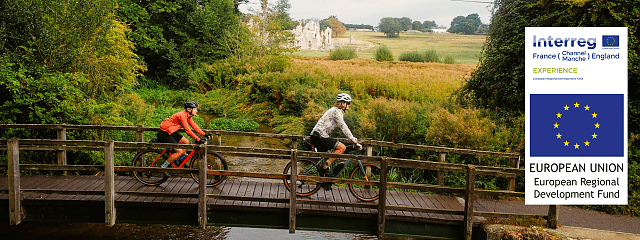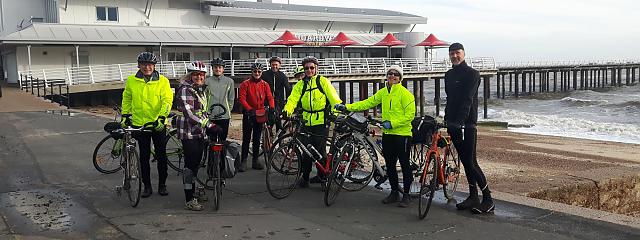Wolf Way
Wolf Way
The Wolf Way is a 248 mile/400km cycling adventure around Suffolk. Winding its way around many of the best bridleways, byways, gravel tracks, cycle paths and quiet back roads, it takes in some of Suffolk’s most beautiful locations and hidden gems.
After seeing the Rebellion Way around Norfolk, bikepackers Chris Bower and Sharon Calton were inspired to create a route to showcase the great riding in their home county, with help and advice from Cycling UK and Suffolk County Council. The Wolf Way is a stunning and accessible multi-day adventure exploring Suffolk’s varied landscape and deep history.
With similar elevation to its Norfolk counterpart, but slightly longer and with a little more off-road sections, the Wolf Way is a great way to experience multi-day riding. The route is designed to be accessible to riders of all levels, guiding them into adventure riding through Suffolk’s stunning scenery.
From the earliest Neolithic settlements in Europe to the Roman cities of Ipswich and Dunwich, Suffolk has a fascinating history. The Wolf Way takes its name from the protector of St Edmund, whose legacy echoes around the whole of Suffolk and East Anglia in place names, monasteries and monuments. It picks up parts of the Icknield Way, one of the ancient ‘King’s Highways’ – wide sandy tracks forged in a time before land enclosure.
The route takes you through beautiful heathland rich with wildlife, like the stone-curlews at Cavenham Heath, wading birds at Minsmere, and Exmoor ponies helping to re-wild Knettishall Heath. Suffolk has 142 Sites of Special Scientific Interest (SSSIs) and you’ll pass close by many of these on the ride. You'll also pay a visit to the most easterly location in the British Isles, at Ness Point in Lowestoft.
Facilities
Terrain
The terrain is best described as ‘undulating’. There is very little elevation, with the highest point a mere 375ft above sea level, and no steep climbs.
There are several sections that are very sandy (especially in dry weather) which might lead to a few squeals from those unfamiliar with sandy tracks. The sandy terrain through Breckland is well drained, making it ridable all year round.
East Anglia is one of the driest parts of the UK, but there are plenty of pubs and breweries on the route to quench your thirst, including the iconic St Peters Brewery built on the site of Flixton Priory dating back to 1280.
Route overview
The Wolf Way is a circular route with a start and finish in Bury St Edmunds, which can be easily reached by train. There are seasonal variants to make things more interesting.
Main Wolf Way route: between April and September, you can take the Deben Ferry from Felixstowe Ferry to Bawdsey Quay. Download GPX file
Winter Wolf: from October to March, this version takes you via a spectacular coastal bridleway through Trimley Marshes. Download GPX file
East Wolf: a shorter option (171 miles/274km) that starts and finishes at Ipswich rail station, heading up the east coast to Ness Point then looping back via Ed Sheeran’s ‘Castle on the Hill’ in Framlingham. Download GPX file
Wolf Cub: this 60 mile/100km loop provides a taster of the Wolf Way which can be completed in a day. Download GPX file
St Edmund and the wolf
The route starts by the statue of St Edmund and his guardian the wolf in Abbey Gardens, Bury St Edmunds, a short ride from the station. You head out of town on quiet cycle paths towards Bradfield St Clare. Not far from here is the SSSI Bradfield Woods, a remnant of ancient wildwood, where you can find ancient, coppiced ash trees thought to be 1,000 years old.
Cuckoos and dragons
As you continue south towards Thorpe Morieux, you’ll pass the crash site of the flying fortress B17G, marked with a plaque. A little further down the trail, you’ll find a memorial dedication with some remnants of mangled metal and a board detailing what happened on 27 March 1944.
Not far from here you’ll reach the medieval wool town of Lavenham, with its half-timbered houses and 15th-century church. The town has featured in several movies including Harry Potter and the Deathly Hallows, and the crooked house on the high street inspired the nursery rhyme ‘There was a crooked man’. Close by is the similarly picturesque Brent Eleigh – where you can stop for a coffee and cake in the lovely gardens of Café Como, a popular cycle destination.
Continuing south you soon reach Long Melford. In the country park, the route joins an old railway line which skirts around Sudbury and Great Cornard, into the Stour Valley and on to Bures. Here you can head up Cuckoo Hill to the viewpoint and see the mythical Bures Dragon carved into the adjacent hillside. You ride through the western tip of Dedham Vale AONB, past Arger Fen and Tiger Hill.
On reaching Hadleigh, you join another disused railway line, before continuing eastwards to Ipswich. Following cycle paths through the city and along the Orwell, past the ships in Ipswich Docks, you’re within easy reach of the station, hotels and other facilities. A gentle climb through Hollywell Park then you’re heading out for the east coast.
From UFOs to fairytales
All the routes will take you through the Suffolk Coasts and Heaths AONB, starting in Rendlesham Forest. This is the location of a Britain’s Roswell-equivalent UFO sighting, near RAF Woodbridge, and is marked by a UFO trail which leads you to the mothership in the heart of the forest.
A little further along as you approach Butley is something even more remarkable: Staverton Park and the Thicks. This has to be one of the most magical places in the UK, where the country’s tallest holly trees tower over ancient pollard oaks. It is place of Tolkienesque wonder and beauty, with its hordes of marching Ents, and should not be missed.
Soon you will be in Orford Ness, where you can take a ferry over to Europe’s largest shingle spit and explore the nature reserve that was once a military radar and atomic testing site. Thorpeness is Suffolk’s unique holiday village. Created in the Edwardian period, it has Tudor- and Jacobean-style homes, including the ‘House in the Clouds’ and the Magical Mere, a Peter Pan-inspired boating lake.
At the Leiston Gap you’ll see the imposing hulk of the Sizewell B Power station, and can stop for a brew at the ‘Sizewell T’ café and spot seals swimming in the warm sea there. A spectacular bridleway through the heart of the Minsmere RSPB reserve takes you to Dunwich.
Dunwich
Dunwich was once the capital city of the East Angles, until the harbour became blocked in a huge 13th century storm and coastal erosion destroyed it. Some of the old priory remains, and Dunwich beach is the destination of the overnight cycle ride the Dunwich Dynamo every summer.
Southwold is next, home to the famous pier, lighthouse and the Adnams Brewery. It’s a great place for fish and chips on the seawall or any other of the cornucopia of foody delights – including George Orwell’s former family home, now a fish and chip shop at the end of the high street.
Lowestoft is a busy harbour town, and you’ll have to join the traffic to cross over the Waveney’s inner harbour. However, you’re soon back onto a quiet cycle path heading for the UK’s most easterly point. It’s marked with a giant compass pointing to nearby cities over the seas, giving you the distance were you able to glide there like an albatross.
You follow a lovely section of EuroVelo route 12, the North Sea coastal route, along the seawall, until you reach Links Road which climbs steeply back up into the city.
The couples’ curse
Now you follow more cycle paths and quieter roads back to re-cross the Waveney at Oulton Broad, a popular park with cafés overlooking the water. Then its westwards, skimming the top of the Norfolk Broads at Mutford and Beccles. The terrain opens up to vast skies as you continue through the two St Ilketshalls, with St Peter’s Brewery a lonely oasis in this fenland landscape.
You cross the Waveney a third time at Mendham, just south of Harleston, then it’s on to Hoxne, where St Edmund was martyred – his hiding place under the Goldbrook bridge being given away by a glint of his gold spurs to a newly married couple. St Edmund put a curse on all couples crossing the bridge on their way to get married, which is still strong to this day.
Hoxne is also where the Hoxne Hoard was found, Britain’s largest collection of silver and gold coins, now residing in the British Museum and said to be worth more than £2.6m. Not far from Hoxne is Eye, named after the old English word for island, indicating its watery past.
Next you will reach Mellis with its beautiful common, and ride down Cow Pasture Lane, which was famously saved by local environmentalist and author Roger Deakin. His novel Waterlog revitalised wild swimming in Britain and he spent years restoring and tending Walnut Tree Farm to be a haven for wildlife.
Roman roads
Eventually you’ll arrive at Knettishall Heath, another SSSI and start point of the Peddars Way, an ancient Roman road linking the Icknield Way with the Norfolk coast at Holme-next-the-Sea. The Angles Way and Iceni Way also meet here. If you’re lucky you might catch a glimpse of the Exmoor ponies and grab a coffee from the café van in the visitor car park.
You join the Icknield Way here and follow wide sandy tracks through the Euston Estate to Berner’s Heath, past an old concrete tank target, then down the rutted rollercoaster tracks of Deadman’s Grave to the beautiful flowing trails through Cavenham Heath, stopover place for stone-curlews at the end of summer.
You can grab a last-minute coffee and cake at the Purple Pantry when you approach Cavenham village. You’re now approaching journey’s end, coming back into Bury St Edmunds via Risby and Fornham All Saints.
Extend your ride
If you have lots of time, you could even combine the Wolf Way with the Rebellion Way for a wonderfully rewarding loop around Suffolk and Norfolk.










